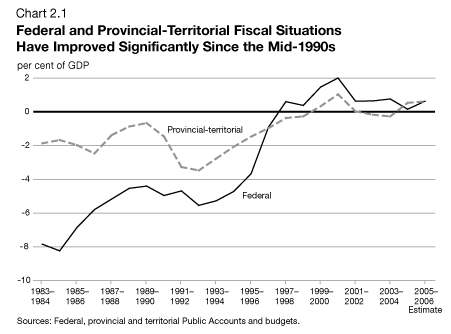 |
|
| Table of Contents Previous Next | |
Chapter 2:
Concerns Over Transparency in Federal Fiscal Planning
Prior to the late 1990s, both orders of government went through a sustained period of running fiscal deficits, resulting in rising debt-to-GDP ratios. The deficits were clearly unsustainable, and both orders of government significantly reduced program spending in order to bring their respective finances under control. (Annex 2 describes in greater detail the evolution of the federal and provincial-territorial fiscal situation in recent decades.)
Several provinces led the way to a return to sound public finances. The federal government was able to record its first surplus in 1997–98 and has since had eight consecutive years of surplus. Progress toward balanced budgets proceeded at a different pace in different provinces and territories: they achieved a combined positive budgetary balance in 1999–2000 and posted combined positive budgetary balances in five of the past seven years.

Benefits From Sound Finances
There is strong agreement that this return to sound finances has generated many benefits for Canada and Canadians:
- It has allowed governments to reduce their debt and, combined with strong economic growth, has resulted in a reduction in debt-to-GDP ratios. The federal debt-to-GDP ratio fell from a peak of 68.4 per cent in 1995–96 to 38.3 per cent in 2004–05. Provincial and territorial government debt ratios also declined—albeit unevenly across provinces and territories and not as dramatically overall as for the federal government—to an aggregate debt-to-GDP ratio of 22 per cent.
- It has allowed both orders of government to cut taxes.
- It will help governments prepare for the fiscal consequences of population aging, which will result in increased expenditures on such things as elderly benefits and health, and slower revenue growth, as the labour force begins to shrink.
While the restoration of Canada’s fiscal health has been a positive development, federal surpluses over the last eight years have generally been larger than anticipated, generating considerable controversy. On average, the federal budgetary balance has been $5.6 billion better than forecast in the budget each year since 1997–98. Over the same period, aggregate provincial budgetary balances also exceeded their forecast by $4.7 billion a year on average.

Reasons for Larger Than Anticipated Surpluses
An independent review of the federal government’s fiscal forecasting process in 2005 by the International Monetary Fund (IMF) found that Canadian federal budget projections of macroeconomic and fiscal aggregates have been more cautious than those in other countries since the mid-1990s, resulting in a consistent underestimating of budget balances and the largest average forecast errors among the countries examined.
There are two reasons why these better than expected results have occurred:
- The strength of the Canadian economy:
- A prudent approach to fiscal forecasting: The federal government adopted a high degree of prudence in its fiscal planning to meet the firm commitment of achieving a balanced budget or better in every single year in the face of significant economic and fiscal uncertainty. This approach reflected the concern that the credibility of federal budgeting needed to be re-established in the financial markets, so it was imperative to build a track record of budget surpluses. The IMF concluded: "a conservative budgeting approach constitutes a rational response to a regime where the costs of missing a fiscal target are both high and asymmetric, as has been the case in Canada over the past ten years."
Concerns Over Larger Than Projected Surpluses
The repetition of much larger than projected surpluses has led to three recurring criticisms of federal budgeting from participants in the current debate over fiscal relations:
- There are perceptions that the federal government has not been as transparent as it could have been with Parliament, Canadians and other orders of government—the amount of prudence effectively incorporated in budget planning was larger than the announced public guidelines to ensure balanced budgets.
- A significant portion of the federal surpluses was also unplanned, resulting in large, last-minute, year-end spending that was not always guided by a pre-announced policy framework. This reduced the scope for parliamentarians and Canadians to have an informed debate on how these fiscal dividends were allocated.
- Most prominently, large federal surpluses were used in part to spend in areas of primarily provincial responsibility, which has led many to believe that the federal government has more than enough fiscal capacity to meet its spending requirements, particularly in comparison to provinces and territories, which continue to face considerable spending pressures.
| Table of Contents Previous Next |
|
|
|||||
| Last Updated: 2006-05-02 | |||||